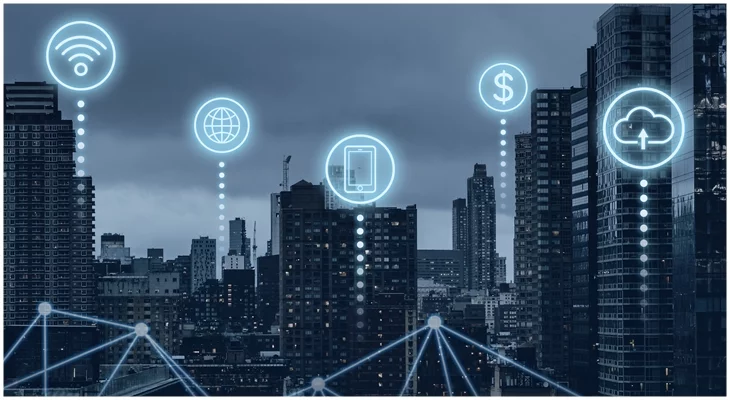Edge computing can visualize businesses in real-time. Retailers can make the most of edge computing to give their customers the best experience possible. As a result, edge computing is one of the most effective ways to improve the business and reintroduce customers to retail stores. Continue reading to know more about Edge Computing and its benefits to the business industry.
Edge Computing: An Introduction
Edge computing is a distributed IT architecture. It processes the client's data close to the source at the network's periphery.
Data is the lifeblood of modern business. It also allows for valuable business insight. It also gives real-time control over critical business processes and operations. Data is routinely collected from sensors and IoT devices. These devices operate in remote locations and inhospitable operating environments.
But, the way businesses handle computing is changing as a result of this massive amount of data. The traditional computing paradigm is not suited to handling huge amounts of real-world data. Bandwidth constraints, latency issues, and unpredictably disrupted networks can all sabotage such efforts. Edge computing architecture helps businesses to address these data challenges.
Edge computing moves some storage and compute resources closer to the data source. Processing and analysis of data are done at the place of data generation. This data source can be in a retail store, a factory floor, a sprawling utility, or across a smart city. The results of that computing work at the edge are sent back to the main data center for review and other human interactions. It gives real-time business insights, equipment maintenance predictions, or other actionable answers.
- Ways Edge Computing Can Visualize Businesses
- Data Management And Improved Healthcare Device Performance
- Analyzing Retail Data in Real-Time on a Local Level
- Enhanced Augmented Reality
- Better Data Analytics
- Manufacturing Technology that is Intelligent
- Removing Excess Information
- Security Systems That Are More Efficient
- Data Collection in the Real World
- Lower Operating Costs and Storage Requirements
- Medical Diagnosis And Treatment That Is More Accurate
- Edge Computing Can Visualize Businesses in the Retail Industry
Ways Edge Computing Can Visualize Businesses
Data Management And Improved Healthcare Device Performance
Use edge computing to improve the IT infrastructure in the healthcare industry. Edge computing is useful for medical device management. It helps to avoid application performance latency issues. Healthcare data processing can be localized instead of relying on a single centralized data center. It also increases security, faster response, and more efficient data transmission.
Analyzing Retail Data in Real-Time on a Local Level
Edge computing brings computation close to the point of data generation. In the retail industry, data is traditionally gathered in one central location. It is then analyzed and then acted upon. Retail stores can use edge computing to optimize locally and in real-time. Edge computing enables organizations to make data-driven decisions more quickly.
Enhanced Augmented Reality
Edge computing will unlock profound capabilities for augmented reality. It will allow unprecedented levels of user engagement to take place on devices. AR experiences will also be more vivid, faster, and improved for users. As a result, many aspects of the business will be ready for change. Companies that take advantage of these advantages early on will have a better chance of succeeding.
Better Data Analytics
Edge computing's local computation brings high levels of intelligence into the data analytics process. This allows you to generate a more precise set of data and speed up analysis and decision-making. Otherwise, intelligence in the cloud is less refined and applied later in the process. As a result, analytics take longer and are less focused than they could be.
Manufacturing Technology that is Intelligent
To achieve smart manufacturing, edge computing is required. Performing near-real-time analysis allows for significant improvements in operational efficiency and margins. Line shutdowns can be avoided by detecting process anomalies that affect yield. Edge computing systems collect data to create smart tools such as digital twins.
Removing Excess Information
In traditional cloud computing architectures, data accumulates in cloud storage. Because the majority of this data is useless, businesses waste a lot of money storing data they will almost never use. Edge computing can help by only sending useful data to the cloud for processing.
Security Systems That Are More Efficient
Edge computing can improve efficiency and reduce bandwidth usage. It can be beneficial for businesses with large and complex security systems. For example, data from motion-detection cameras is continuously streamed to a cloud server. But, with edge computing, each motion-detection camera would have its own internal computer. It would run the application and send footage to the cloud server as needed.
Data Collection in the Real World
Edge computing is built into IoT, digital signage, and the IP fabric that is being assembled for retail and enterprise. The future of business depends on data mining and the collection of trillions of data points. Edge computing enables businesses to gather this data. It also helps them to use cloud services in conjunction with on-premise equipment and sensors. This helps to collect real-world data without requiring consent.
Lower Operating Costs and Storage Requirements
Edge computing eliminates the need to send collected data back to a central server. This translates to lower operating costs and fewer storage requirements.
Medical Diagnosis And Treatment That Is More Accurate
Medical IoT devices at the edge can aid in the faster and earlier detection of abnormal changes. This would result in faster response times. It would also increase the ability of doctors to diagnose and treat patients. Storage and processing, as well as sensors, are becoming more affordable with wearables.
Edge Computing Can Visualize Businesses in the Retail Industry
Big Data & Analytics
Edge computing is an ideal candidate to take advantage of technologies like the Internet of Things.
Edge computing's entire method is aimed at bringing data processing closer to the source of the data. To bring what will soon be essential features to enterprises that adopt it, such as real-time data processing and analytics. By allowing retailers to collect and analyze data at the source, they gain access to a plethora of new services and revenue streams. This includes opportunities to use technology offerings like AI and digital signage technologies.
Enhancing Operational Effectiveness
Many retailers rely on their edge computing infrastructure to provide insights. It helps them to best leverage their technological resources. Thus they are able to promote the highest level of operational efficiency. This isn't limited to improving customer experiences or understanding trends.
Artificial intelligence and machine learning technologies can combine with edge computing. They aim to improve retailers' abilities and analyze customer and operational data in great detail.
Edge computing also helps to connect better and synchronize in-store, online, and mobile services. It also improves operational efficiency while also enabling unique and bespoke customer experiences. It also helps to open up new revenue streams on new and future platforms.
Customized Customer Experience
There is a continued expansion of the Internet of Things. Also, the increased connectivity with systems and technologies has opened up many ways to connect and engage with customers. Retailers can also tailor their advertising and marketing efforts to match their customers' tastes. They can also recommend new products or offers based on their previous purchasing decisions. By using edge computing, they can gather and analyze data such as purchase history.
Recognizing Consumer Trends
Edge computing is also assisting retailers in gaining insights into how customers are likely to behave in-store and online. It does so by analyzing data collected when they use physical or online services.
This data can help create predictive models of future behavior. Also, taking into account what drives decision-making with the help of AI or automation technologies. Understanding how customers react to certain trends allows retailers to tailor the shopping experiences to their preferences.
Surveillance and Security
IoT and edge computing can help to understand data better. It also improves customer experiences as well as operational efficiency. Edge computing systems are also helpful to new security and surveillance technologies. It also provides improved security and surveillance capabilities to cameras and sensors.
Multi-functional motion sensors help to determine which areas of the store receive the most human traffic. They also increase customer and employee security. Edge computing can improve biometric security. Thus allowing better access for employees while also preventing unauthorized access.
Conclusion
Retailers can make the most of edge computing to give their customers the best experience possible. As a result, edge computing is one of the most effective ways to improve the business and reintroduce customers to retail stores.
Edge computing can also help revitalize retail shopping. It can do so by allowing online shopping apps and in-store devices to communicate with one another. We may see more advancement in technology and its application. This would be a result of the introduction of various computing solutions. The initiative to use technology to provide the best possible experience for customers sets the standard for how other businesses should proceed.





